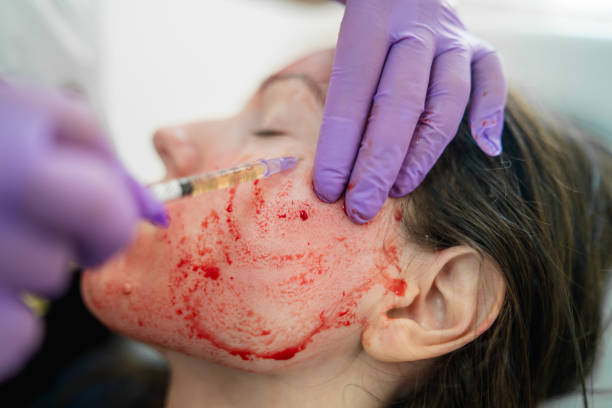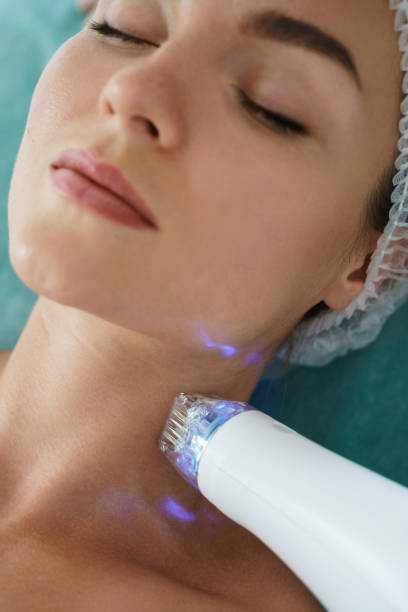Microneedling is a cosmetic procedure that involves using small needles to puncture the skin and stimulate collagen production. While it is generally considered safe for most people, there are certain individuals who should avoid microneedling or use caution when considering the procedure. Here are some examples:
- Pregnant or breastfeeding women: The effects of microneedling on pregnant or breastfeeding women have not been extensively studied. To err on the side of caution, it is generally recommended to avoid microneedling during these periods.
- Active skin infections or conditions: If you have an active skin infection, such as herpes simplex (cold sores) or impetigo, or if you have active acne, rosacea, eczema, or psoriasis flare-ups, microneedling may not be suitable. The procedure can potentially aggravate these conditions or spread the infection.
- Keloid-prone individuals: People with a history of keloid or hypertrophic scarring may want to avoid microneedling, as it can potentially trigger the formation of new scars or worsen existing ones.
- Open wounds, cuts, or abrasions: Microneedling should not be performed on areas with open wounds, cuts, or abrasions. It is important to allow these areas to heal completely before considering the procedure.
- Blood clotting disorders or anticoagulant medication: If you have a bleeding disorder or are taking medications that affect blood clotting, such as warfarin or aspirin, microneedling may increase the risk of bleeding or bruising. It is advisable to consult with a healthcare professional before undergoing the procedure.
- History of skin cancer: If you have a history of skin cancer or are currently undergoing treatment for it, microneedling should be avoided or performed under the guidance of a dermatologist or oncologist.
- Use of certain medications: Some medications, such as isotretinoin (Accutane), can affect skin healing and increase the risk of scarring. If you are taking such medications, it is important to disclose this information to the practitioner before considering microneedling.
It is crucial to consult with a qualified dermatologist or skincare professional to determine if microneedling is appropriate for you. They will consider your medical history, current health status, and individual circumstances to provide personalized advice.

Is microneedling good for all skin?
Microneedling can be beneficial for many different skin types and concerns. It is a versatile procedure that can address a variety of skin issues. Here are some examples of how microneedling can benefit different skin types:
- Aging skin: Microneedling can help stimulate collagen and elastin production, which can improve the appearance of fine lines, wrinkles, and sagging skin. It can also enhance skin texture and firmness, giving a more youthful appearance.
- Acne-prone skin: Microneedling can be effective in reducing acne scars and improving overall skin texture. The tiny needles create micro-injuries that stimulate collagen remodeling, helping to fill in depressed acne scars and create a smoother skin surface.
- Uneven skin tone and pigmentation: Microneedling can help improve hyperpigmentation, sunspots, and uneven skin tone by promoting the production of new, healthy skin cells. It can also enhance the penetration of topical treatments, such as skin lightening agents or serums, to further address pigmentation concerns.
- Enlarged pores: Microneedling can help reduce the appearance of enlarged pores by promoting collagen production and tightening the skin. This can lead to a smoother skin texture and minimized pore size.
- Scarring: Microneedling has been shown to be effective in reducing the appearance of various types of scars, including acne scars, surgical scars, and stretch marks. The controlled micro-injuries created by the procedure can stimulate collagen synthesis, which can help remodel scar tissue and improve the overall appearance of the skin.
- Dull and tired-looking skin: Microneedling can promote skin rejuvenation by enhancing blood circulation and the delivery of nutrients to the skin. This can result in a brighter, more refreshed complexion.
While microneedling can benefit many skin types, it is still important to consult with a qualified dermatologist or skincare professional to assess your specific skin concerns and determine if microneedling is suitable for you. They will be able to provide personalized recommendations based on your individual needs and goals.
Does microneedling make skin age faster?
No, microneedling does not make the skin age faster. In fact, microneedling is often used as a cosmetic procedure to help improve the signs of aging and promote skin rejuvenation. When performed correctly by a trained professional, microneedling stimulates the production of collagen and elastin, which are essential proteins that help maintain the skin’s structure, elasticity, and youthfulness.
The micro-injuries created by the tiny needles during microneedling trigger the skin’s natural healing process, leading to the production of new collagen and elastin fibers. This helps to improve skin texture, reduce the appearance of wrinkles, and promote a more youthful appearance. Microneedling can also enhance the absorption of topical serums or products, allowing for better penetration of active ingredients into the deeper layers of the skin.
It is important to note that after microneedling, the skin may appear slightly red or inflamed for a short period, but this is a temporary side effect. Proper post-treatment care and following the instructions of your skincare professional can help ensure optimal healing and minimize any potential risks or adverse effects.
However, it is essential to have microneedling performed by a qualified professional who adheres to proper hygiene and safety practices. Incorrect technique, unsterilized equipment, or using needles that are too long or too aggressive can potentially damage the skin and lead to negative outcomes. Therefore, it is crucial to seek treatment from a reputable practitioner who has experience in performing microneedling procedures.
Overall, when performed correctly and in the appropriate setting, microneedling is a safe and effective procedure for improving the signs of aging and promoting skin rejuvenation.
What not to do before microneedling?

To ensure a successful microneedling procedure and minimize the risk of complications, it is important to follow certain guidelines and avoid specific activities or products before your treatment. Here are some things you should avoid before microneedling:
- Sun exposure: It is recommended to avoid excessive sun exposure and tanning beds for at least two weeks before your microneedling session. Sunburned or tanned skin can be more sensitive and prone to complications during the procedure.
- Retinoids and exfoliating products: Discontinue the use of retinoids, alpha hydroxy acids (AHAs), beta hydroxy acids (BHAs), and other exfoliating products for several days to a week before microneedling. These products can increase skin sensitivity and make the procedure more uncomfortable.
- Waxing or depilatory creams: Avoid waxing or using depilatory creams on the treatment area for about one week before microneedling. These hair removal methods can irritate the skin, and it is best to allow the skin to calm down before the procedure.
- Active acne breakouts: If you have an active acne breakout or cold sores, it is recommended to postpone microneedling until the skin has healed. Microneedling can potentially spread bacteria and aggravate existing acne or cold sores.
- Blood-thinning medications: If you are taking medications that thin the blood, such as aspirin or anticoagulants, it is advisable to consult with your healthcare professional. They can provide guidance on whether to temporarily discontinue or adjust the dosage of these medications before the procedure.
- Facial injections: Avoid receiving Botox injections, dermal fillers, or other facial injections in the treatment area at least two weeks prior to microneedling. These injections can alter the skin’s structure, and it is important to allow sufficient time for the effects to stabilize.
- Skin infections or open wounds: If you have any active skin infections, cuts, abrasions, or open wounds in the treatment area, it is best to postpone microneedling until the skin has fully healed. Performing the procedure on compromised skin can increase the risk of infection or delay the healing process.
It is crucial to consult with your skincare professional or dermatologist before undergoing microneedling. They will provide specific pre-treatment instructions based on your individual needs and medical history to ensure optimal results and minimize any potential risks.
Is microneedling safe for older skin?
Yes, microneedling can be safe for older skin, but there are some considerations to keep in mind. Microneedling involves using tiny needles to create micro-injuries in the skin, stimulating collagen production, which is particularly beneficial for aging skin as it helps with fine lines, wrinkles, and skin texture. However, older skin may be thinner and more delicate, so it’s important to approach microneedling with extra care.
Here are some key points to consider for microneedling on older skin:
- Professional treatment: It’s safer to have microneedling done by a licensed professional, especially for older individuals, to ensure the procedure is done with the correct depth and technique for aging skin.
- Needle depth: For older skin, shallower needle depths are typically recommended to avoid excessive irritation or damage.
- Frequency: The healing process might take longer with older skin, so treatments should be spaced out to allow proper recovery.
- Skin preparation: Pre-treatment with nourishing serums and post-treatment care is crucial to promote healing and enhance results.
- Skin conditions: If there are existing skin conditions (like rosacea, eczema, or infections), microneedling may not be advisable.
Consulting with a dermatologist is recommended to assess individual skin health and determine if microneedling is appropriate.
